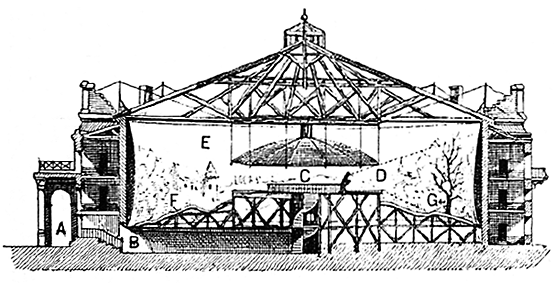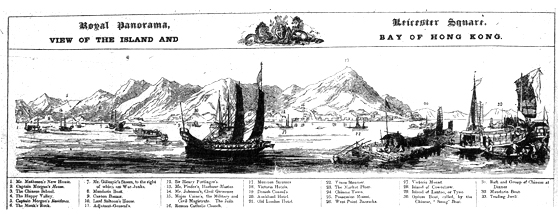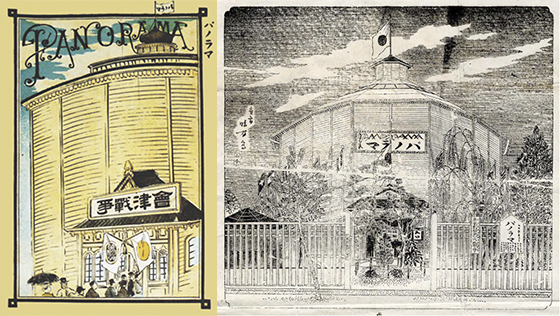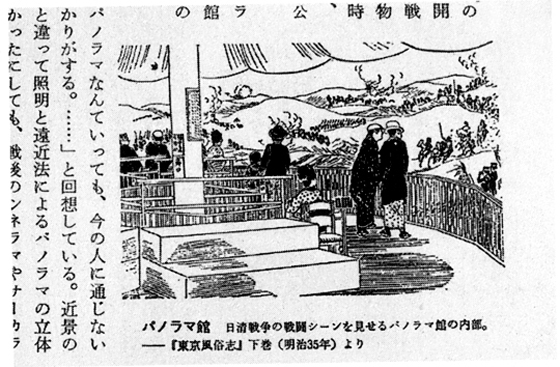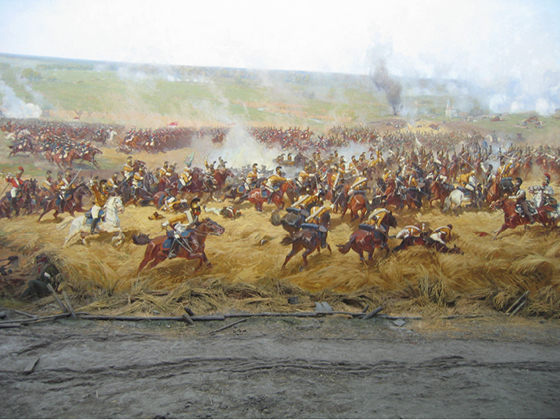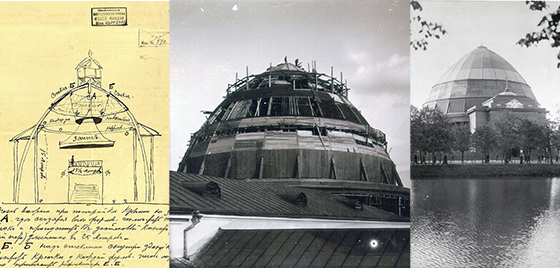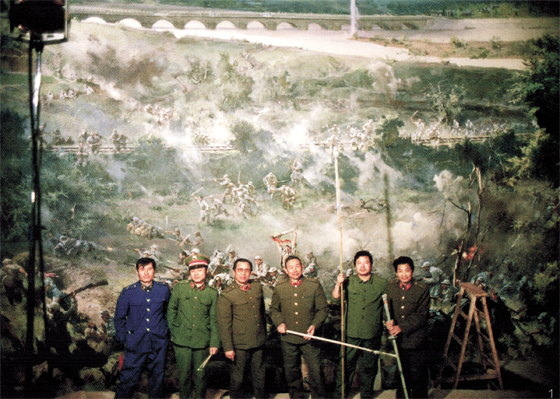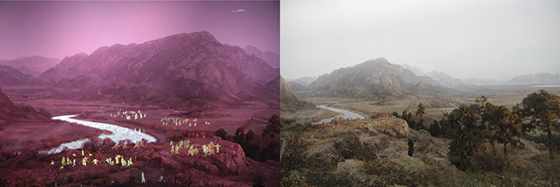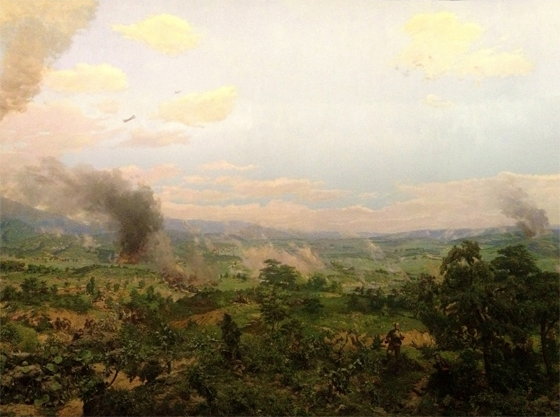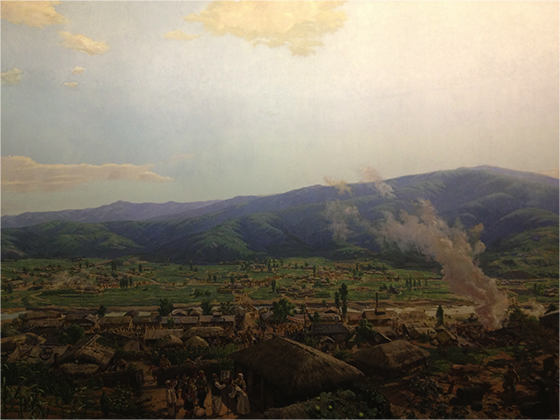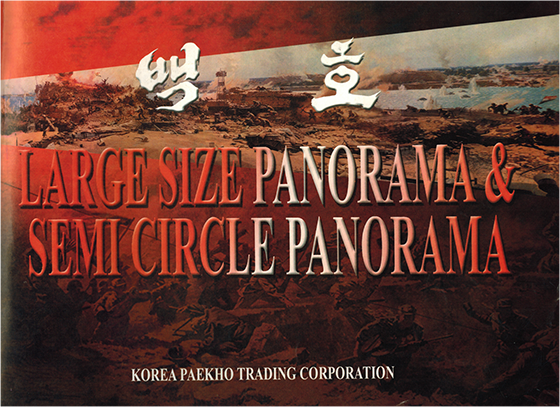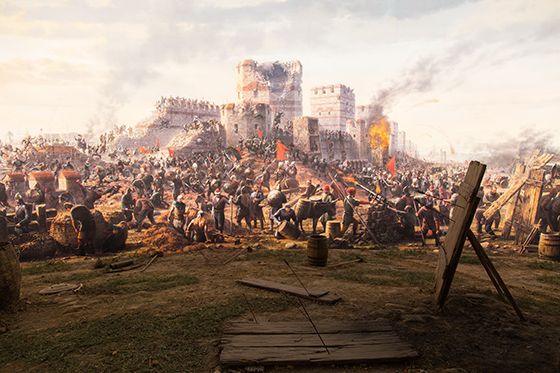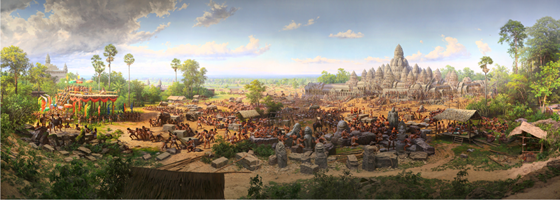History
A Concise History of the Panorama
The Panorama is an art form which encircles the spectator with an illusion of continuous space, often in a painted 360º format. Patented by Englishman Robert Barker in 1787, this spectacular visual entertainment flourished throughout the 19th century, mostly in Europe and the United States. The Panorama, Cyclorama, Diorama, Cosmorama and other multitudinous variations on the sensational venue were popular places to spend leisure time and embark upon imagined travels to unfamiliar and significant places in space and time.
Cross section of a panorama:
(A) Box office and entrance.
(B) Dark corridor and cylindrical center staircase.
(C) Observation platform.
(D) Viewer's field of vision.
(E) 360-degree circular canvas.
(F) Three-dimensional faux terrain elements.
(G) Trompe l'oeil elements painted directly onto canvas.
A Concise History Of Panoramas Of The Near & Far East
Panoramas are a worldwide phenomenon, uniting art and illusion. The beginning took place in Edinburgh, Scotland, 1787, with Robert Barker and his twelve-year-old son Henry Aston. Henry, a savant and magic lover, regarded fooling the eye (trompe l’oeil) integral to the enchantment of the panorama. Onlookers would see the curved 360-degree painting as if it were in the third dimension, as if they were transported to another place at another time, the same as it was, but then, somehow different.
Robert & Henry presented panoramas in London (England) and then in Paris (France), Rome (Italy), Moscow in Russia and Constantinople/Istanbul (Turkey). Others began making panoramas too, such as Adam Breysig, a renowned stage designer who made the first locally painted panorama Rome From The Palatine Hill in Berlin, Germany.
Section of Burford’s Panorama, Leicester Square. From Robert Mitchell’s Plans and Views in Perspective of Buildings Erected in England and Scotland, 1801.
During the Opium Wars, China became a prominent topic for panorama paintings, being a pre-cinematic artistic medium of newsworthy or salacious topics - wars, sieges, battles or otherwise idyllic city views. Starting in the 1830s, panoramas such as View of Canton, panorama of Macao, A View of the City of Nanking, and View of the Island and Bay of Hong Kong, by Robert Burford, successor to Robert Barker and accomplice of Henry Aston.
Key to Robert Burford'sView of the Island and Bay of Hong Kong. Ralph Hyde, "Panoramas - A Brief Introduction to a World-Wide Phenomenon",
The World of Panoramas. Ten Years of International Panorama Conferences, 2003.
Ralph Hyde, esteemed panorama historian, supposes that the first panorama to be seen in China or Japan was Mr. & Mrs. Birch’s moving panorama Holiday Trip, or a Run Through the Continent, most likely first shown in Shanghai and then in Yokohama, Japan. By the late 19th Century, panoramas were on the decline in the West, where they were born, and on the rise in the East, where they were reborn. The Attack on Pyongyang, was exhibited in Asakusa Park, Tokyo, where several panorama rotundas, or panorama-kan, could be found. No true panorama paintings from Japan remain today nor any of the panorama-kan, as by 1910 the last Great Panorama of Asakusa was demolished and replaced by a cinema palace.
Panorama-kan in Japan, Machiko Kusahara, "We Will Open the Panorama-kan": The beginnings of the 'Panorama Craze' in Meiji Japan, 2004
Interior of a panorama-kan in Tokyo, c. 1900 - Kenjiro Hirade, Tokyo Fuzoku-shi, Tokyo 1902*
In the 1830s, the Russian-born Franz A. Roubaud started painting panoramas for Russian markets, such as The Battle of Borodino, completed in 1912 and on view today at the Panorama Museum in Moscow, though not in its original wooden pavilion rotunda. Roubaud’s studio assistant was M.B. Grekov, a well known battle artist in his own right. The M.B. Grekov Studio, a studio of Red Army art, exists today where contemporary artists are creating panoramas and dioramas such as the Panorama of the Battle of Stalingrad, completed in 1982, depicting a scene from the 1942/1943 battle.
Battle Of Borodino by Franz Roubaud & photos of the Panorama Museum of Moscow
The Battle of Borodino Panorama Museum - http://www.1812panorama.ru/english.html
The first panorama created in China was The Lugouqiao Incident. Created in 1988, the painting depicts scenes from the Japanese invasion of China in 1937, and is on view at the Museum of Chinese People’s War of Resistance Against Japanese Aggression in Beijing. It is a half-circle panorama as opposed to a full 360-degree, but is a massive 16 meters (52 feet) high and 52 meters (170 feet) long, and was painted by Mao Wenbiao, He Kongde, and Yang Keshan.
The Lugouqiao Incident, by Mao Wenbiao, He Kongde, and Yang Keshan & others, Beijing c.1988
Xia Shushen, "Introduction to the Development of the Panorama in China", The World of Panoramas. Ten Years of International Panorama Conferences, 2003.
The first 360-degree panorama was The Siege of Jinzhou, which debuted in Jinzhou in 1989, and depicts scenes from the War of China’s Liberation. Xia Shushen finds that since “the year 2000, ten panoramas - six full circle and four half-circle panoramas - have been finished in China,” most by artist from the Luxun Academy of Fine Arts. Of note is also the Splendid Central Plains panorama which depicts Henan Province and is, according to Guinness Book of World Records, the largest painting in the world and includes an elaborate light and projected image cycle shown in the picture below.
Splendid Central Plains, by Li Fulai, Yan Yang, Li Wu, Zhou Fuxian - Luxun Academy of Fine Arts, Shenyang
In 1974, the Democratic People’s Republic of Korea erected its first panorama, the Taejon Liberation Operation, depicting a pivotal moment of the Korean War in which Major General William F. Dean surrenders. This panorama is housed in Pyongyang’s Victorious Fatherland Liberation War Museum and stands 16 meters high and spans 152 meters long. The most prominent panorama-painting group in the country is the Korea Paekho Trading Corporation which has created multiple panoramas nationally and internationally in countries such as Iraq, Egypt, and Syria. It is estimated that Korean artists have created at least 40 panoramas of various sizes within the Democratic People’s Republic of Korea. These panoramas commonly depict war scenes and are often accompanied by other auxiliary media such as video, audio explanations, musical scores, and lighting effects.
Taejon Liberation Operation, Victorious Fatherland Liberation War Museum
In 2009, Istanbul opened The Panorama 1453 Museum of History to house The Conquest of Constantinople 360-degree, domed panorama. The painting covers 2,350 square meters and measures 38 meters in diameter. It depicts the morning of May 29, 1453--the moment when Ottoman troops broke through Byzantine defenses to conquer Constantinople.
The Conquest of Constantinople, by Hasim Vatandas, Ramazan Erkut, Yasar Zeynalov, Oksana Legka, Ahmet Kaya, Hasan H. Dincer, Atilla Tunca, Murat Efe,
The Panorama 1453 Museum of History - http://www.panoramikmuze1453.com/
Around this same time period, several panoramic paintings have been created such as the Sakarya Pitched Battle and the Battle of Çanakkale, housed in the ATATÜRK and the War of Independence Museum. However, they are not on view in round structures--instead as dioramas on flat walls.
Sakarya Pitched Battle, by Sergey N. Prisekin
Australia’s first panorama came in 1892, the Cyclorama of Early Melbourne, a view of Melbourne in 1841, based on a panoramic pen and wash picture sketched by the Melbourne pioneer architect and builder, Samuel Jackson. The cyclorama was actually painted by the Melbourne scenic and panoramic artist, John Hennings. Although it is currently off-view, a number of panoramas have been created since 2001, with Peter Anderson’s The Big Picture depicting the outback. Unlike most countries’ military panoramas, Australia’s panoramas deal primarily with ambient, native landscapes. In May 2017, the Jeff Morgan Gallery unveiled his latest work the Arkaroola Panorama, depicting the Nooldoonooldoona watering hole in the Arkaroola Wilderness Sanctuary.
Arkaroola Panorama, courtesy of Jeff Morgan - http://www.jeffmorgangallery.com.au/
In Seam Riep, Cambodia, the Angkor, Age of Prosperity panorama was created by North Korean artists in 2015, at the Angkor Wat temple complex. It stands 12.9 meters high and spans 122.6 meters long and is split into three sections depicting the defense, construction, and prosperity of the Khmer Empire. And in the Neotropical Butterfly Park of Wanica, Suriname is The Landscapes and Nature of Suriname panorama painted by Wim Eriks in 2010.
Angkor, Age of Prosperity, by Mansudae Art Studio - http://angkorpanoramamuseum.com/
Many more panoramas exist or have existed throughout Asia that are not mentioned here - for instance in India and Malaysia. If you are a panorama in Asia (or elsewhere) that is not listed here and you would like to be included, please send your history and a reference image or two to: panorama[at]panoramaonview.org
References:
Shushen, Xia."Introduction to the Development of the Panorama in China", The World of Panoramas. Ten Years of International Panorama Conferences, 2003.
Kusahara, Mahicko. "We Will Open the Panorama-kan': The beginnings of the 'Panorama Craze' in Meiji Japan", The Panorama in the Old World and the New, 2004.
Huimin, Song. "The Panorama in China Today", The Panorama in the Old World and the New, 2004.
Hyde, Ralph. "Panoramas - A Brief Introduction to a World-Wide Phenomenon" The World of Panoramas. Ten Years of International Panorama Conferences, 2003.
Tae Sun, Ryom. "Panoramas in the Democratic People's Republic of Korea"
This project is supported in part by the National Endowment for the Arts.
